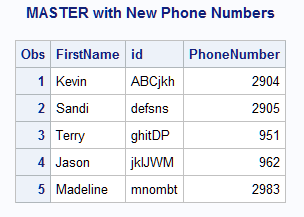REPLACE Statement
Replaces an observation in the same location.
| Valid in: | DATA step |
| Category: | Action |
| Type: | Executable |
| Restriction: | Use only with a MODIFY statement. |
Syntax
Arguments
- data-set-name
-
specifies the data set to which the observation is written.Requirement:The data set name must also appear in the DATA statement and in one or more MODIFY statements.Tip:Instead of using a data set name, you can specify the physical pathname to the file, using syntax that your operating system understands. The pathname must be enclosed in single or double quotation marks.
Comparisons
-
Using an OUTPUT, REPLACE, or REMOVE statement overrides the default write action at the end of a DATA step. (OUTPUT is the default action; REPLACE becomes the default action when a MODIFY statement is used.) If you use any of these statements in a DATA step, you must explicitly program output of a new observation for the step.
Example: Replacing Observations
This example updates
phone numbers in data set MASTER with values in data set TRANS. It
also adds one new observation at the end of data set MASTER. The SYSRC
autocall macro tests the value of _IORC_ for each attempted retrieval
from MASTER. (SYSRC is part of the SAS autocall macro library.) The
resulting SAS data set appears after the code:
data master;
input FirstName $ id $ PhoneNumber;
datalines;
Kevin ABCjkh 904
Sandi defsns 905
Terry ghitDP 951
Jason jklJWM 962
;
data trans;
input FirstName $ id $ PhoneNumber;
datalines;
. ABCjkh 2904
. defsns 2905
Madeline mnombt 2983
;
data master;
modify master trans;
by id;
/* obs found in master */
/* change info, replace */
if _iorc_ = %sysrc(_sok) then replace;
/* obs not in master */
else if _iorc_ = %sysrc(_dsenmr) then
do;
/* reset _error_ */
_error_=0;
/* reset _iorc_ */
_iorc_=0;
/* output obs to master */
output;
end;
run;
proc print data=master;
title 'MASTER with New Phone Numbers';
run;